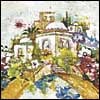Looking Back and Looking Forward
A scholar once presented a copy of his novellae regarding the sacrificial service in the Beis HaMikdash to R. Baruch of Mezibush for an approbation. After receiving no reply, he asked R. Baruch the reason for his hesitation.
“I haven’t been able to look at your book,” R. Baruch answered. “Please understand. It has nothing to do with you or your scholarship. It’s my problem.
“Every morning when I recite the passage Azehu mekomon shel zevachim, — ‘Where is the location of the sacrifices?’ — in the morning prayers, I contemplate the destruction of the Beis HaMikdash and I am overcome with remorse. There is no way I could bear to read an entire text on the subject.”
There are, however, two ways of looking at the subject. Instead of looking back to the destruction of the Beis HaMikdash, one can look forward to the Third Beis HaMikdash which will be built by Mashiach.
This is surely the spirit in which this book was composed. As explained in the first essay1 our Sages2 consider the study of the Beis HaMikdash equivalent to its actual construction. Moreover, this study hastens the coming of the time when we will actually be able to build this structure.
Relevant Now More Than Ever
On the eve of the 28th of Nissan, 5751, the Lubavitcher Rebbe, of righteous memory, initiated a heightened consciousness of the imminence of the Future Redemption. In the subsequent months, the Rebbe continued to emphasize how the Redemption is not a hope for the distant future, but a reality which is becoming increasingly manifest from day to day. Every individual carries a responsibility to do whatever he can to precipitate this process.
What we must do, the Rebbe has repeatedly reiterated, is “live in the spirit of the Redemption,” and acclimate our lives to this new framework of reference. To facilitate this process — and as a catalyst to hasten the Redemption’s coming, he has mentioned the importance of studying the subjects of the Redemption, Mashiach, and the Beis HaMikdash, and in particular, appreciating the treatment of these subjects by the Chabad Rebbeim.3
To enable English readers to internalize these concepts, we published I Await His Coming, an adaptation of analytical studies by the Rebbe, of righteous memory, on the Rambam’s description of the coming of Mashiach and the Era of the Redemption. And with the intent of enabling readers to become familiar with the Beis HaMikdash and its service, the present text offers an adaptation of similar studies by the Rebbe that focus on the Rambam’s conception of the Beis HaMikdash.
A Unique Approach to the Study of Torah
The presentation of these studies is organized according to the structure of the Rambam’s Hilchos Beis HaBechirah and touches on many of the different halachic dimensions relevant to these laws.
These studies serve as a characteristic example of the Rebbe approach to the study of Nigleh, the revealed, legal dimension of the Torah. A broad-scoped, but penetrating and abstract conception of the laws is combined with a perception of the parallels to these concepts that exist in the spiritual dimension of our divine service. In regard to the subject matter at hand, we are given an inclusive and intellectually challenging conception of the laws regarding the construction of the Beis HaMikdash, which simultaneously shows the parallels to these concepts that exist in the inner sanctuary for G‑d every Jew possesses within his heart.
We realized that this book might not necessarily be read from cover to cover in one sitting, and that the essays might be referred to as independent pieces. Therefore, several of the references and indeed, certain concepts within the text itself, are repeated so that each individual essay can be comprehended as a distinct unit.
* * *
These studies were translated and adapted by Rabbi Eliyahu Touger and edited by Ben Baird. The text as a whole was structured and prepared for printing by Rabbi Yonah Avtzon, director of Sichos in English. The layout, typography, and illustrations which greatly enhanced the text are the products of Yosef Yitzchok Turner’s efforts. The cover was designed by Avrohom Weg.
Sichos In English
Lag BaOmer, 5754






Start a Discussion